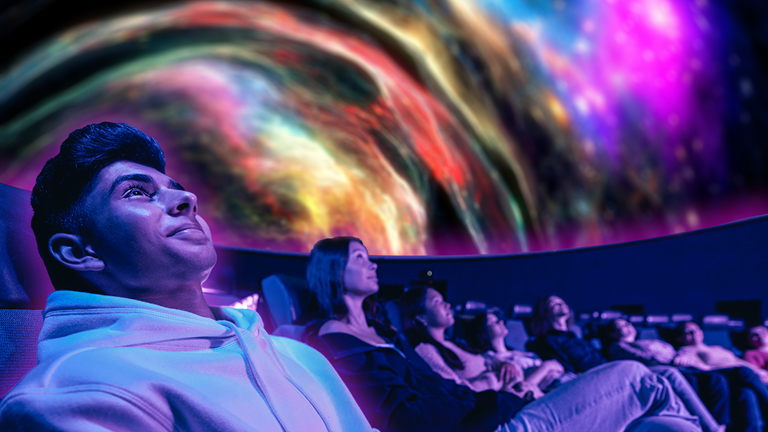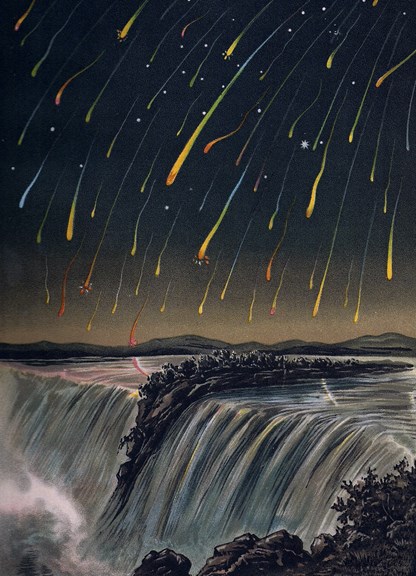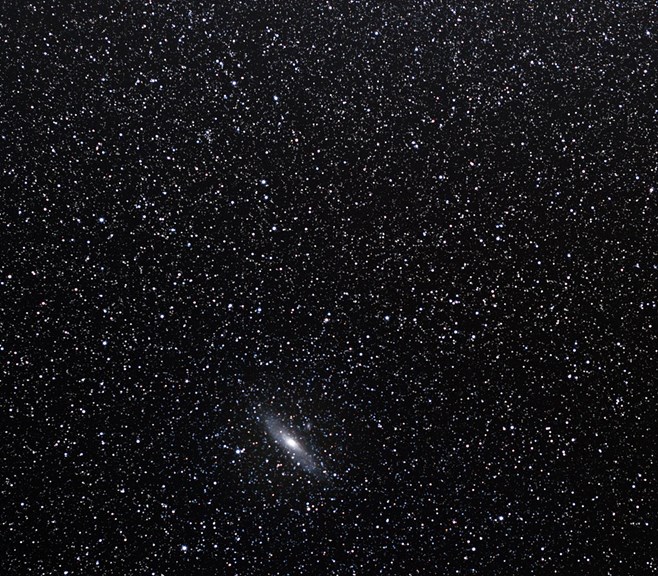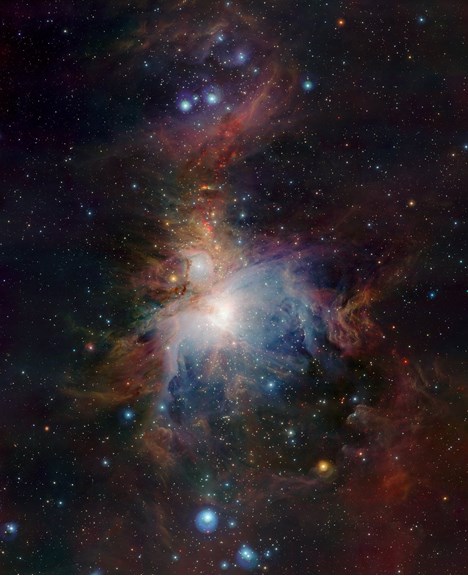
Planetarium Nights
Experience science and art in an evening of immersive cinema for adults 18 years and over.
Congratulations Victoria, you did it!
We are delighted to welcome visitors back to Scienceworks, the Melbourne Planetarium and all other Museums Victoria venues from Saturday 30 October.
Bookings are essential. See our FAQs for information about entry conditions and our visitor information to help you plan your visit.

Experience science and art in an evening of immersive cinema for adults 18 years and over.
The natural phenomenon of a partial lunar eclipse will take place this month on night of the 19th. Melbourne will miss the start of it with the moon below the north-eastern horizon but as our neighbour rises it will only have just reached its maximum so we can still can enjoy the sight, followed later by the impressive full moon.
Eclipses can only ever happen at full moon when the moon is on the side of Earth opposite the Sun and its Earth-facing hemisphere is fully illuminated by sunlight. Occasionally, however, at full moon its path will briefly bring it into our planet’s shadow and we can marvel at an eclipse.
However, no two eclipses are ever quite the same for two principal reasons. Firstly, the moon’s distance from Earth varies by about 50,000km in an orbit that is not circular but elliptical, and secondly the moon takes a path that is tilted a little over 5 degrees in relation to Earth’s orbit around the sun. For most full moons our lunar neighbour entirely misses the narrow cone of our planet’s shadow that reaches out into space well beyond the moon’s orbit. On those occasions no eclipse can take place. But if the moon’s distance and the orientation of its orbit are just right then it will enter Earth’s shadow. For some eclipses it will graze our shadow and for others it will move deep into it. This complex ‘shadow dance’ creates the different lunar eclipses we see from Earth.
This month’s partial lunar eclipse will see the moon move almost completely, but not totally, into the Earth’s full shadow (the umbra). A clear view to the eastern horizon with no trees or buildings to block the view will be required, and a high viewing location would be good as well.
From Melbourne, the eclipse will begin about an hour and a half before the moon rises and reach its maximum a few minutes before moonrise. As our planet rotates in an easterly direction the moon will rise clear of the horizon for the partial eclipse to then be fully visible. Over the next hour and a half as the moon gradually rises higher it will slowly move out of Earth’s shadow and the eclipses will be over. But then we can experience another delight – a full moon for the remainder of the night.
| Partial Eclipse begins | 6:18pm (below horizon) |
| Eclipse maximum | 8:02pm (below horizon) |
| Moonrise | 8:09pm |
| Melbourne maximum | 8:12pm (moon fully visible) |
| Partial Eclipse ends | 9:47pm |
| Date | Rise | Set | Day length | Solar noon§ |
|---|---|---|---|---|
| Mon 1 | 6:13 | 7:54 | 13:41 hrs | 1:03 |
| Thu 11 | 6:03 | 8:05 | 14:02 hrs | 1:04 |
| Sun 21 | 5:56 | 8:16 | 14:20 hrs | 1.05 |
| Tue 30 | 5:52 | 8:25 | 14:33 hrs | 1.08 |
§When the Sun is at its highest, crossing the meridian or local longitude
| Phase | Date |
|---|---|
| New Moon | Fri 5th |
| First Quarter | Thu 11th |
| Full Moon & Lunar Eclipse | Fri 19th |
| Third Quarter | Sat 27th |
The Moon will be at perigee (closest to Earth) on Sat 6th at 358,844 km and apogee (furthest from Earth) on Sun 21st at 406,274 km.
Mercury again is not visible this month as it is moving behind the sun.
Venus continues as the bright ‘evening star’ in the west in the constellation of Sagitarrius (in the archer’s bow and arrow area, or Teapot asterism). It is visible from 8pm and setting by midnight in early November, and from 8.30pm and setting about 11.30pm late in the month.
Mars is now behind the sun and so not visible this month. After its pass around the sun the Red Planet will return to our early morning skies in January.
Jupiter remains in the centre of the constellation of Capricorn high in the north-west. It is visible from 8pm setting by 2.30am early in the month, and by the end of the month from 8.30pm before setting around 1.30am.
Saturn is fainter and below Jupiter also sitting in Capricorn. Early in November it can be seen in the west from 8.30pm until setting around 1.30am, and by the end of the month from 9pm before setting by 1am.
This month we have two meteor showers although neither is expected to feature more than ten to fifteen meteors an hour if conditions are good.
First up are the Taurids, an old meteor stream peaking in the first week of November. They can be bright, slow moving, with occasional colourful fireballs. One branch appears near the star cluster Pleiades and the other near the red star Aldebaran in Taurus which rises in the north-east around 10pm. Around 10 per hour can be seen, but every few years activity increases with brighter meteors and more fireballs.
Later will be the Leonids from 13th - 20th peaking on the morning of the 18th. As was the case last month with the Orionids resulting from Earth passing through the trail of particles left behind by past visits of Comet Halley, so too the Leonids result from Comet Tempel-Tuttle that orbits the sun every 33 years. It reached perihelion (closest to Sun) in 1998 after which thousands were seen globally per hour. Since then the rate has been about 15 per hour. They appear in the direction of Leo, the lion, which rises in the north-east around 4am, are fast and leave lots of trains that can last several minutes.
From NASA here is an extraordinary photo of perhaps a dozen Leonids diving into and vapourising in Earth’s atmosphere. Stars of the constellation of Aries are at top and a full moon is reflected on clouds at lower left. This CCD image was taken in 1997 in low orbit by the US Air Force Space Command MSX satellite (Midcourse Space Experiment that ran from 1997 to 2013).
This Wikipedia image shows an 1889 engraving by Adolf Vollmy of the famous Leonids meteors of 1833. It was derived originally from an eyewitness account of seeing hundreds of thousands of meteors falling per hour. Just imagine what that must have been like!
That many would classify not as a meteor shower, but a rare meteor storm. In recent times, however, the Leonids have been far less impressive, and this month the moon will be approaching full moon phase which will reduce the number of visible meteors.

ISS orbits every 90 minutes at an average distance of 400 km appearing like a bright star moving slowly across the night sky. Here are some of the brightest passes expected this month over Melbourne and Central Victoria:
Evening
Mon 1st 9.45pm-9.49pm South-West to North-West
Tue 2nd 8.58pm-9.03pm South-West to East-North-East
Morning
Sat 26th 5.10am-5.16am North-West to South-East
Sun 27th 4.24am-4.25am North-North-West to East-South-East
Heavens Above gives predictions for visible passes of space stations and major satellites, live sky views and 3D visualisations. Be sure to first enter your location under ‘Configuration’.
In the north
The constellation of Pegasus, the winged horse is in the north this month with Andromeda low in the north-west. Aquila (the Eagle) and its principal star Altair (Alpha Aquilae) is now in the north-west.
Low in the north this month, and into December, if you are in an area free of light pollution you may just be able to find the most distant object visible to the naked eye - the Andromeda Galaxy. It occupies an area in the sky larger than the moon but appears as a faint smudge. It lies in the constellation of Andromeda (hence the name). Look low in north, below and to the right of the square of Pegasus, the winged horse. Watch NASA’s Swift Tour of Andromeda Galaxy.

In the west
Scorpius is spectacular as that constellation has now moved fully to the west with the red-giant star Antares noticeable as the middle of three stars that form the centre of the arachnid’s body. Above lies the centaur-archer Sagittarius with its bow and arrow forming the well-known asterism, the Teapot. Higher up, where Saturn and Jupiter are this month, is Capricorn, the sea goat (a goat with the tail of a fish).
In the east
It’s still spring, but be prepared for some wonderful summer constellations in the east! Just beginning to appear this month in the late evening is Orion, the hunter with one of his feet, the blue-giant star Rigel, leading the way followed a little later in the night by one of his shoulders, the red-giant star Betelguese. The three stars that form Orion’s belt are also the base of the Saucepan asterism. The scabbard which hangs from his belt forms the saucepan’s handle. From our southern hemisphere perspective Orion and Saucepan are upside down. In the centre of the scabbard or handle lies the beautiful and extraordinary Orion nebula - a vast gas cloud. It is a stellar nursery where new stars are formed.

In the north-east and also starting to rise later in the night is Taurus, the bull with the red-giant star Antares. And in the south-east will rise the brightest star at night, Sirius (Alpha Canis Majoris), also known as The Dog Star in Canis Major, greater dog.
Truly a beautiful and popular concentration of constellations and stars to enjoy on that side of the night sky over the summer. They will appear higher in the east in the evening as the weeks go by.
In the south
Continuing low in the south this month is Crux (Southern Cross) with the two Pointers, Alpha and Beta Centauri, to its right in the constellation Centaurus. In the south-east shines the second brightest star at night, Canopus (Alpha Carinae), the principal star for the constellation Carina, the Keel.
If away from city or town lights, you can certainly enjoy an evening view of the broad expanse of the Milky Way stretching from south-east, along the western horizon to north-west. As the night progresses with the Earth rotating to the east you can observe the Milky Way slowly ‘wheel’ across the sky so that by 3am it will run from the western horizon over your head (the zenith) to the eastern horizon. Here in the southern hemisphere we enjoy some of the best view of our galaxy!
1st 1963, then largest radio telescope, the Puerto Rico Arecibo Observatory, opens utilising a natural valley and transceiver suspended from pylons on nearby peaks.
3rd 1957, Laika, a 3-year husky-Samoyd dog, became the first animal into orbit in Sputnik 2 (USSR). While never intended to return to Earth, she expired from heat stress after only a few hours.
3rd 1973, Mariner 10 (USA) launches to Mercury, the first probe to use a gravitational ‘slingshot’ around a planet to reach an objective (in this case, Venus).
4th 2003, largest solar flare recorded causes radio blackouts and saturates satellites, and was associated with a Coronal Mass Ejection (CME) many times larger than Earth leaving the Sun at 2,300 kph.
8th 1656, birth of second Astronomer Royal Edmund Halley who calculated several historical comets to be the same. He successfully predicted its regular 76-year return. It posthumously carries his name.
9th 1934, birth of American astrophysicist and science communicator Carl Sagan.
12th 2014, First landing on a comet and direct surface images of Comet Churyumov-Gerasimenko by Philae lander from ESA’s Rosetta probe.
12th 1980, Voyager 1 (USA) has historic close encounter with Saturn at 124,000km. It then flew by moon Titan which precluded going on to Uranus or Neptune, although both were later visited by Voyager 2.
13th 1971, Mariner 9 (USA) is the first spacecraft to orbit another planet, Mars. Months of a planet-wide dust storm finally cleared to allow pictures of the surface.
15th 1738, discoverer of Uranus and infrared radiation, William Herschel, is born.
14th 2003, Sedna, a TNO (Trans Neptunian Object) is discovered in a 11,400 year elongated orbit, one of the most distant objects known in the Solar System.
16th 1965, Venera 3 (USSR) is launched to Venus becoming the first probe to reach the surface of another world.
16th 1974, first radio message sent into space (USA/Puerto Rico). ‘Arecibo Message’ to star cluster M13 25,000 light years away took 3 min. Its 1,679 binary 1’s and 0’s if arranged in 23 columns and 73 rows will reveal visual information (prime numbers 23 x 73 = 1,679).
17th 1970, Lunokhod 1 (‘Moon Walker’, USSR) first remote-controlled moon rover. Delivered by lander Luna 17, it drove 10km and lasted 321 Earth days, far longer than the expected 3 months.
20th 1998, First module for the ISS, Russia’s 12 metre Zaryu (‘Sunrise’) or Functional Cargo Block, is launched beginning a multi-module multi-year assembly of the space station in low Earth orbit.
26th 2012, Curiosity rover (USA) arrives in Mars’ Gale Crater after a high-speed entry and first use of an innovative final landing technique – the ‘sky crane’.
27th 1971, first probe to reach the Martian surface is Mars 2 (USSR) although it crashes in the process.
27th 2001, first detection of composition of exoplanet’s atmosphere – by Hubble Telescope for planet Osiris orbiting a sun-like star 150 light years away.
28th 1967, Cambridge postgraduate student Susan Jocelyn Bell discovers the first pulsar, initially named LGM1 for “little green men”. Its regular 1.3 sec radio pulse revealed these pulsating stars to be rapidly spinning neutron stars.
29th 1967, Australia becomes the third nation after USSR, USA and France to launch a satellite from its own territory. The 45kg WRESAT-1 (Weapons Research Establishment Satellite) made 642 polar orbits until re-entry 11 days later.
30th 1609, Galileo studies the Moon with his improved telescope, and while not the first to do so he was the first to explain mountains and craters, and chart lunar features and their heights.
30th 1954, Ann Elizabeth Hodges of Alabama, USA, becomes the first person injured by a meteorite. She was badly bruised by a 5kg rock that crashed through her roof, deflected off a radio cabinet, and hit her while she was asleep on the couch.
Museums Victoria acknowledges the Wurundjeri Woi Wurrung and Boon Wurrung Bunurong peoples of the eastern Kulin Nations where we work, and First Peoples across Victoria and Australia.
First Peoples are advised that this site may contain voices, images, and names of people now passed and content of cultural significance.